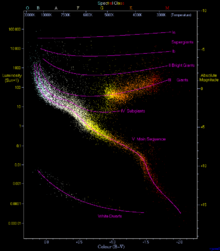| Observation data Epoch J2000.0 Equinox J2000.0 | |
|---|---|
| Constellation | Ophiuchus |
| Right ascension | 17h 04m 27.84s ± 5.62[1] |
| Declination | −28° 34′ 57.64″ ± 3.16[1] |
| Apparent magnitude (V) | 6.7258 ± 0.005[1] |
| Characteristics | |
| Spectral type | K0V |
| B−V color index | 0.814 ± 0.034[1] |
| Astrometry | |
| Radial velocity (Rv) | 14.2972 ± 0.0003[2] km/s |
| Proper motion (μ) | RA: 83.76 ± 0.64[1] mas/yr Dec.: -268.69 ± 0.36[1] mas/yr |
| Parallax (π) | 56.06 ± 0.50 mas[1] |
| Distance | 58.2 ± 0.5 ly (17.8 ± 0.2 pc) |
| Absolute magnitude (MV) | 5.47 ± 0.02 |
| Details | |
| Mass | 0.97 ± 0.05[3] M☉ |
| Radius | 0.95 ± 0.03[4] R☉ |
| Luminosity | 0.68 +0.06 −0.05 (log -0.169 ± 0.033)[5] L☉ |
| Surface gravity (log g) | 4.40 ± 0.11[3] cgs |
| Temperature | 5423 ± 51[3] K |
| Metallicity [Fe/H] | 0.31 ± 0.03[3] dex |
| Rotation | 42.6 ± 4.4[6] |
| Rotational velocity (v sin i) | 1.9 ± 0.5[5] km/s |
| Age | 3 - 8[3] Gyr |
| Other designations | |
| Database references | |
| SIMBAD | data |
HD 154088 is a seventh magnitude metal-rich K-type main sequence star that lies approximately 58 light-years away in the constellation of Ophiuchus. The star is orbited by a hot Super-Earth.
Properties

HD 154088 is a modestly bright star that lies at the bottom of Ophiuchus, near to the border with Scorpius and near to the plane of the Milky Way. The star was recognised as a high proper motion star during the last century, and early Earth-based parallax measurements such as that of the Gliese Catalogue of Nearby Stars indicated a distance of about 50 light-years.
The star has a spectral type of K0V, indicating that it is a main sequence star that is about 350 degrees cooler than the Sun. On the Hertzsprung-Russell diagram (left), the star lies slightly above the main sequence. This is because the star is very metal-rich; with an Fe/H of 0.3 dex the star has about twice the solar abundance of iron, which makes HD 154088 fall into the somewhat vague group of super metal-rich (SMR) stars. The giant planet occurrence rate of Fe/H = 0.3 stars is on the order of 30%, but HD 154088 is not currently known to host any giant planets.
HD 154088 has a pronounced magnetic field.[3] It also has a magnetic cycle similar to the Sun,[6] though its length is not well constrained.
The survey in 2015 have ruled out the existence of any additional stellar companions at projected distances from 8 to 119 astronomical units.[7]
Planetary system
A planet orbiting HD 154088 discovered with the HARPS spectrograph was announced in September 2011. With a minimum mass of 6 Earth masses, the companion falls into the regime of Super-Earths.
| Companion (in order from star) |
Mass | Semimajor axis (AU) |
Orbital period (days) |
Eccentricity | Inclination | Radius |
|---|---|---|---|---|---|---|
| b | ≥6.15 ± 0.86 M🜨 | 0.1316 ± 0.0021 | 18.596 ± 0.021 | 0.38 ± 0.15 | — | — |
HD 154088 is also being observed under the Keck Eta-Earth radial velocity survey.[8] HD 154088 b is a close match for planet candidate 1 (orbital period = 18.1 days, minimum mass = 6.5 M🜨), so they may be the same detection. The planet existence was finally confirmed in 2021.[9]
References
- ^ a b c d e f g van Leeuwen, F. (2007). "Validation of the new Hipparcos reduction". Astronomy and Astrophysics. 474 (2): 653–664. arXiv:0708.1752. Bibcode:2007A&A...474..653V. doi:10.1051/0004-6361:20078357. S2CID 18759600.
- ^ a b Mayor, M.; et al. (2011). "The HARPS search for southern extra-solar planets XXXIV. Occurrence, mass distribution and orbital properties of super-Earths and Neptune-mass planets". arXiv:1109.2497. Bibcode:2011arXiv1109.2497M.
{{cite journal}}: Cite journal requires|journal=(help) - ^ a b c d e f Fossati, L.; et al. (2013). "Detection of a magnetic field in three old and inactive solar-like planet-hosting stars". Astronomy. 551: A85. arXiv:1302.0879. Bibcode:2013A&A...551A..85F. doi:10.1051/0004-6361/201220997. S2CID 53377473.
- ^ Takeda, Genya; et al. (2007). "Structure and Evolution of Nearby Stars with Planets. II. Physical Properties of ~1000 Cool Stars from the SPOCS Catalog". The Astrophysical Journal Supplement Series. 168 (2): 297–318. arXiv:astro-ph/0607235. Bibcode:2007ApJS..168..297T. doi:10.1086/509763. S2CID 18775378.
- ^ a b Valenti, J. A.; Fischer, D. A. (2005). "Spectroscopic Properties of Cool Stars (SPOCS). I. 1040 F, G, and K Dwarfs from Keck, Lick, and AAT Planet Search Programs". The Astrophysical Journal Supplement Series. 159 (1): 141–166. Bibcode:2005ApJS..159..141V. doi:10.1086/430500.
- ^ a b Lovis, C.; et al. (2011). "The HARPS search for southern extra-solar planets. XXXI. Magnetic activity cycles in solar-type stars: statistics and impact on precise radial velocities". arXiv:1107.5325. Bibcode:2011arXiv1107.5325L.
{{cite journal}}: Cite journal requires|journal=(help) - ^ Mugrauer, M.; Ginski, C. (12 May 2015). "High-contrast imaging search for stellar and substellar companions of exoplanet host stars". Monthly Notices of the Royal Astronomical Society. 450 (3): 3127–3136. Bibcode:2015MNRAS.450.3127M. doi:10.1093/mnras/stv771. hdl:1887/49340. Retrieved 19 June 2020.
- ^ Howard, Andrew A.; et al. (2010). "The Occurrence and Mass Distribution of Close-in Super-Earths, Neptunes, and Jupiters". Science. 330 (6004): 653–655. arXiv:1011.0143. Bibcode:2010Sci...330..653H. doi:10.1126/science.1194854. PMID 21030652. S2CID 34792507.
- ^ Unger, N.; Ségransan, D.; Queloz, D.; Udry, S.; Lovis, C.; Mordasini, C.; Ahrer, E.; Benz, W.; Bouchy, F.; Delisle, J.-B.; Díaz, R. F.; Dumusque, X.; Lo Curto, G.; Marmier, M.; Mayor, M.; Pepe, F.; Santos, N. C.; Stalport, M.; Alonso, R.; Collier Cameron, A.; Deleuil, M.; Figueira, P.; Gillon, M.; Moutou, C.; Pollacco, D.; Pompei, E. (2021), "The HARPS search for southern extra-solar planets", Astronomy & Astrophysics, 654: A104, arXiv:2108.10198, Bibcode:2021A&A...654A.104U, doi:10.1051/0004-6361/202141351
